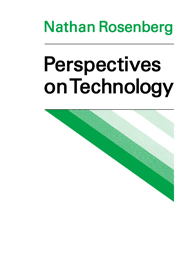Book contents
- Frontmatter
- Contents
- Acknowledgments
- Introduction
- Part 1 Some origins of American technology
- Part 2 The generation of new technologies
- Part 3 Diffusion and adaptation of technology
- 8 Capital goods, technology, and economic growt
- 9 Economic development and the transfer of technology: some historical perspectives
- 10 Selection and adaptation in the transfer of technology: steam and iron in America 1800-1870
- 11 Factors affecting the diffusion of technology
- Part 4 Natural resources, environment and the growth of knowledge
- Epilogue
- Notes
- Index
10 - Selection and adaptation in the transfer of technology: steam and iron in America 1800-1870
Published online by Cambridge University Press: 09 January 2010
- Frontmatter
- Contents
- Acknowledgments
- Introduction
- Part 1 Some origins of American technology
- Part 2 The generation of new technologies
- Part 3 Diffusion and adaptation of technology
- 8 Capital goods, technology, and economic growt
- 9 Economic development and the transfer of technology: some historical perspectives
- 10 Selection and adaptation in the transfer of technology: steam and iron in America 1800-1870
- 11 Factors affecting the diffusion of technology
- Part 4 Natural resources, environment and the growth of knowledge
- Epilogue
- Notes
- Index
Summary
The acquisition of new technologies by noninitiating countries is a subject of major importance and, at the same time, one which has been conspicuously neglected. Historians of industrialization in the past have focused attention forcefully upon the identification of first beginnings and the examination of the claims to priority of different individuals. These questions, indeed, are of basic importance in the history of invention. This preoccupation, however, has led to the neglect of the diffusion process, even within the initiating country. Indeed, the problem has often been assumed out of existence by virtually identifying the date of first technological success with economic impact. This has frequently occurred because, in the past, technological history and economic history inhabited quite different worlds – or at least their authors did. Thus, in his classic account of the steam engine Dickinson, in describing the consequences of the improvement which James Watt had introduced, states that, by the end of the eighteenth century, “The textile industry had been transformed from handicraft into a machine industry.” One must regretfully record that Dickinson, who wrote with such commanding authority on technological matters was, quite simply, a half century off the mark in his economic history.
The point at issue is fundamental because, to put it bluntly, the social and economic consequences of technological changes are a function of the rate of their diffusion and not the date of their first use.
- Type
- Chapter
- Information
- Perspectives on Technology , pp. 173 - 188Publisher: Cambridge University PressPrint publication year: 1976



